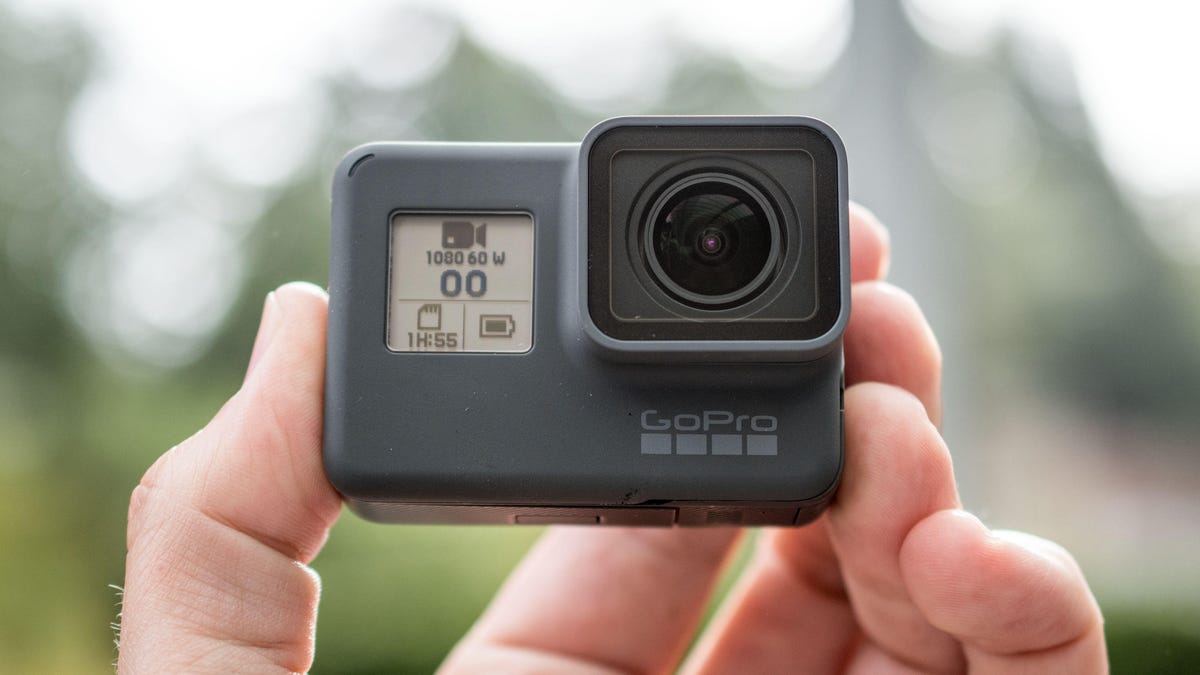GoPro Hero 6 Black IRL: Smoother 4K shots and slower slow-mo
Hands-on with the the company's $499 camera that looks like its predecessor, but a new ingredient means big improvements.

The GoPro Hero 6 Black isn't quite the complete overhaul that its predecessor was, but it does raise the bar on what you can expect out of such a small freakin' camera. It's essentially the whipped cream and chocolate sauce on top of the awesome sundae that is the Hero 5 Black (dammit, now I'm hungry).
The outside doesn't change (it's still waterproof to 10 meters (33 feet), but the addition of a custom-designed processor, the GP1, is responsible for a whole lot of improvements. CEO Nick Woodman said in the past GoPro was building its cameras around off-the-shelf processors. Those chips were available to competitors as well, though.
The GP1 ends that by allowing GoPro to make a camera with the capabilities it wanted. For starters, that means faster frame rates at higher resolutions. The Hero 6 Black can record 4K 2160p-resolution clips at 60fps, which can give fast action a smoother look. And if you're into slow-motion clips, you can record in 1080p at 240fps.
GoPro also claims the chip improves tonal range, color accuracy and low-light quality, as well as extra power to speed up and smarten its QuikStories automated editing feature with face detection and more. Judging by my initial test clips from the Hero 6, it does appear to be improved from the Hero 5, certainly for low-light shots, but I'll need to do a proper side-by-side comparison to be sure.
The processor gave them the headroom to improve the Hero 5's electronic image stabilization promising gimbal-like performance. While I haven't pored over all my videos yet, at first glance this does appear true. Granted, it occasionally looks a little jerky, but I'll take that over nauseatingly unwatchable shakiness any day. It's worth mentioning, too, that it's not available at all frame rates, including 4K at 60fps (you'll have to drop down to 30fps).
Also added is a new digital zoom. Double-tap on the screen and up comes a little slider on the right side. It's nice to have, particularly when paired with the Karma drone, but it only gets you a tiny bit closer, it degraded image quality, and you can't use it once you've started recording. But if you're in the "something is better than nothing" camp, which I generally am, the option is there.
Moar Wi-Fis
GoPro spent much of the past year building out its mobile apps to make it easier for users to shoot, edit and share with their phones. Of course, before those last two happen you need to get your videos off the camera and onto your phone, which is time consuming and a battery drain. To that end, the Hero 6 Black has faster 5GHz Wi-Fi for speedier transfers, three times faster according to GoPro. But, you know, three times faster than slow is still kind of slow, and while an informal test did show improvement, I'll need to see how it holds up in real life.
I do have to say the experience of getting the camera connected to your phone has become about as painless as possible. Plus, once you establish the initial connection, the low-energy Bluetooth maintains a persistent link between your device and the camera, so you can open the app and start using it in a few seconds.
At $499, £500 or AU$750, it's $100 more than the Hero 5 Black, which stays in the lineup along with the Hero 5 Session and the original Session. If you have the money, the Hero 6 Black seems to be worth the investment. Until I'm done testing, I can't say if it's a must-have upgrade for Hero 5 Black owners, but going by features alone, it's probably not. On the other hand, if you were already considering jumping from a Hero 3 or 4 to a Hero 5, it's probably worth saving up to get the Hero 6 Black for the image stabilization and video quality alone. I'll know for sure once I'm done testing.
GoPro's Fusion 360-degree camera is almost here.
But that's not all
The company also provided an update about its 5.2K Fusion 360-degree camera, which was seeded with some commercial testers over the summer. We've been wondering how much it was going to cost -- would it have prosumer or pro pricing? -- and today we got the answer: It's shipping in November for $699, £700 or AU$1,000.
Fusion highlights:
- Offset lenses
- In-camera stabilization
- Overcapture, which records more than the footage necessary for the 360 scene and flattens it so you can use any section independently, reconstructed in software as if you were cutting a multicam shot (in a free update to the GoPro app, available 2018).
Finally, a firmware update for the Karma drone adds Follow and Watch modes that use the controller's GPS to track a subject, as well as Hero 6 Black compatibility. Those options were noticeably absent when the Karma was released last year. I tested it out briefly, and it works well and is quick to respond to direction changes. However, the subject has to be carrying the controller -- and have its screen up and open -- in order to follow. By comparison, industry leader DJI's drones use location and visual tracking for more precise subject tracking.



